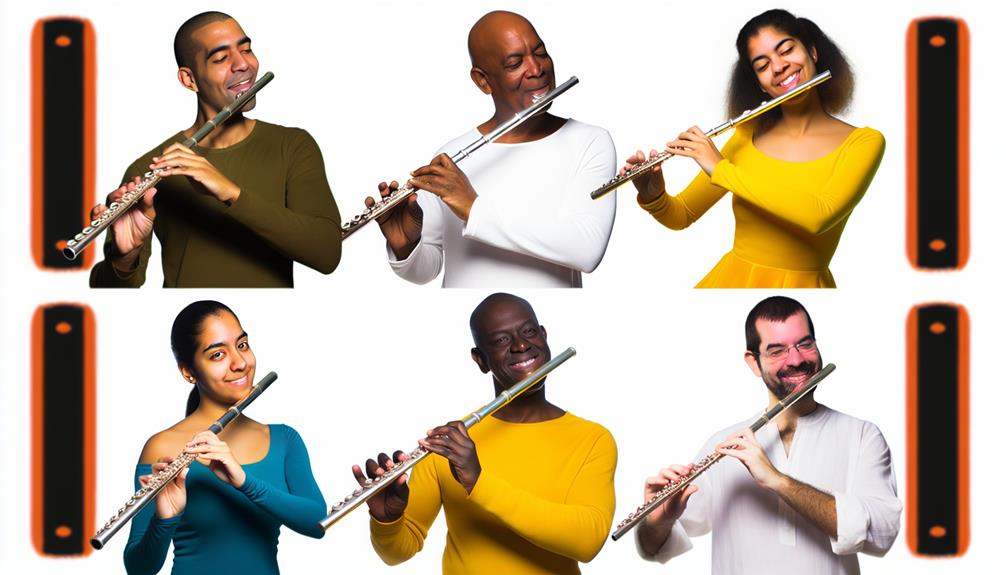Exploring the realm of creating and recording flute covers of popular songs unveils a realm where musical artistry meets innovation. The flute, with its melodious tones and vast repertoire of expression, offers a unique avenue for reinterpretation and reinvention of well-known tunes. From selecting the right songs to skillfully adapting them to the flute's nuances, each step in this process requires meticulous attention to detail. However, the true magic lies in the transformative power of these covers, where familiar melodies take on a new life, enticing listeners to discover a fresh perspective on beloved tracks.
Key Takeaways
- Understand the original song's structure and emotional resonance.
- Adapt melodies to fit the flute's range and capabilities.
- Pay attention to detail in arranging covers for flute.
- Focus on sound quality and technical precision while recording.
- Share covers to engage with a wider audience and explore collaborations.
Choosing Suitable Songs
When selecting songs for flute covers, it is essential to consider both the musical structure and the emotional resonance of the original piece. Selecting melodies that translate well onto the flute is crucial. A good melody will have a balance of range, rhythm, and phrasing that suits the capabilities of the flute. Additionally, finding inspiration in songs that have a strong emotional impact can help create a captivating flute cover.
Finding inspiration for flute covers can come from various sources. It could be a song with lyrics that resonate with the flutist on a personal level, evoking a particular emotion that they wish to express through their playing. Alternatively, instrumental tracks with powerful melodies can also serve as great inspiration. The key is to choose songs that speak to the flutist artistically and emotionally.
Melodies that have a clear and memorable structure tend to work well for flute covers. These melodies often have a strong sense of direction and development, allowing the flutist to showcase their musicality and interpretation skills. Songs with repetitive motifs or hooks can also be effective, as they provide opportunities for variation and embellishment, adding depth to the flute cover.
Adapting Songs for Flute
Adapting songs for flute requires a meticulous understanding of the original composition's nuances and the flute's unique capabilities to ensure a seamless transition into a captivating flute cover. One of the key aspects of adapting songs for flute is transposing melodies. This involves changing the key of the original song to fit the range of the flute, ensuring that the melody sits comfortably within the instrument's limitations. Transposing melodies is crucial in maintaining the essence of the original song while making it playable and enjoyable on the flute.
In addition to transposing melodies, adding embellishments is another essential element in adapting songs for flute. Embellishments such as trills, grace notes, and vibrato can bring a unique flair to the cover, making it more engaging and dynamic. These embellishments not only showcase the flute's capabilities but also add a personal touch to the performance, allowing the flutist to showcase their musicality and creativity.
When adapting songs for flute, it is important to strike a balance between staying true to the original composition and incorporating new elements that highlight the flute's strengths. By carefully transposing melodies and adding embellishments thoughtfully, flutists can create captivating flute covers that resonate with audiences and showcase the beauty of the instrument.
Arranging Your Flute Cover
Crafting an effective arrangement for your flute cover involves meticulous attention to detail and strategic utilization of the flute's versatile capabilities. When arranging a flute cover of a popular song, it is essential to consider melody variations and dynamics. To make your cover engaging and unique, experiment with changing the melody slightly while staying true to the original tune. This can involve adding embellishments, altering the rhythm, or playing the melody in a different octave to give it a fresh perspective. Dynamics play a crucial role in breathing life into your arrangement. By varying the volume and intensity of your playing, you can create contrast and add emotional depth to the music.
Phrasing techniques are another key aspect to consider when arranging your flute cover. Pay attention to how you divide the musical phrases, where you add breaths, and how you connect different musical ideas. Experiment with different articulations and dynamics to bring out the nuances of the song. Ornamentation is also a valuable tool in arranging a flute cover. Adding trills, grace notes, or other embellishments can enhance the expressiveness of your performance and make it more captivating for the listener.
Recording Your Flute Cover
Successful recording of your flute cover requires meticulous attention to sound quality and technical precision. When it comes to capturing the best possible sound, mastering mixing techniques and understanding microphone placement are crucial elements.
Mixing techniques play a significant role in blending the various layers of your flute cover harmoniously. Experimenting with different levels of reverb, equalization, and panning can help create a rich and balanced sound. By fine-tuning these elements, you can ensure that your flute cover maintains clarity and depth throughout the recording.
Moreover, microphone placement is another critical factor that can make a substantial difference in the quality of your recording. Placing the microphone at the right distance and angle from your flute can help capture the nuances of your playing accurately. Close-miking techniques can highlight the intricate details of your performance, while room miking can add a sense of space and ambiance to your cover.
Sharing Your Flute Covers
In the realm of flute covers, the act of sharing your musical renditions serves as a pivotal gateway to connecting with a wider audience and showcasing your artistic interpretation. Sharing your flute covers allows you to not only express your creativity but also engage with a community of music enthusiasts who appreciate your talent.
Here are some key considerations when sharing your flute covers:
- Collaboration Opportunities: Sharing your flute covers on online platforms opens up the possibility of collaborating with other musicians. Collaborations can introduce fresh perspectives, styles, and audiences to your music, fostering growth and creativity in your musical journey.
- Copyright Concerns: Before sharing your flute covers, be mindful of copyright laws. Ensure you have the necessary permissions or licenses to cover and share copyrighted songs to avoid potential legal issues.
- Promotion Strategies: To reach a larger audience, consider promoting your flute covers through social media, music forums, and collaborations with influencers. Engaging with your audience through interactive content and behind-the-scenes glimpses can also help boost visibility and engagement.
Frequently Asked Questions
Can I Use My Own Original Compositions for Flute Covers?
When considering whether to use original compositions for flute covers, it is essential to understand the legal implications. Original arrangements can be a creative way to showcase your musical skills, but copyright clearance is crucial.
Make sure you have the necessary permissions for any copyrighted material you plan to cover, as unauthorized use can lead to legal issues. By obtaining proper clearance, you can confidently create captivating flute covers that comply with copyright laws.
Is It Necessary to Have Formal Music Training to Create Flute Covers?
Formal music training is valuable for aspiring musicians, but it may not be necessary to create flute covers. Self-taught flutists can harness their passion and dedication to develop skills.
Online resources offer a wealth of tutorials, sheet music, and educational materials. While formal training can provide a strong foundation, self-directed learning can also lead to proficiency and creativity in making flute covers.
Ultimately, a blend of formal training and self-teaching can enhance musical abilities.
How Can I Prevent Copyright Issues When Covering Popular Songs?
When covering popular songs, preventing copyright issues involves securing copyright clearance or licensing from the original song's rights holders. Understanding fair use and public domain laws can also guide your approach.
Respect intellectual property rights by obtaining necessary permissions or ensuring that your use falls within legal boundaries. Seek legal advice to navigate complex copyright regulations and protect yourself from potential infringement claims.
What Equipment Is Best for Recording High-Quality Flute Covers?
When aiming for high-quality flute cover recordings, selecting the right equipment is paramount. An exceptional flute microphone is crucial for capturing the nuances of the instrument. Additionally, proficient editing software enhances the post-production process, allowing for refined sound manipulation.
Employing effective recording techniques and soundproofing rooms contribute significantly to achieving professional results. It is advisable to invest in reliable gear and hone recording skills to produce top-notch flute covers that captivate the audience.
Are There Any Tips for Promoting My Flute Covers on Social Media?
In the realm of promoting content on social media, effective marketing strategies and engagement tactics are paramount. Understanding social media algorithms and utilizing them to amplify audience reach can significantly impact the visibility and reception of your flute covers.
Conclusion
In the world of music, creating and recording flute covers of popular songs is akin to painting a masterpiece on a blank canvas. Each note, each embellishment, and each arrangement is a brushstroke that adds depth and beauty to the original composition.
By sharing these covers, artists invite listeners to embark on a journey of discovery and interpretation, where the familiar becomes new and the ordinary becomes extraordinary.





